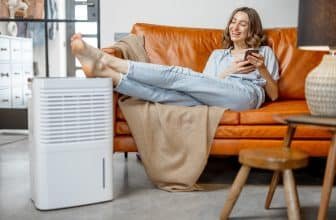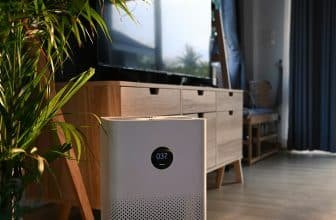Does Air Purifiers Work: Evaluating Their Effectiveness
Breathing clean air is essential for good health, and many people are turning to air purifiers as a solution. Air purifiers work by using filters and fans to remove pollutants and particles from the air, improving indoor air quality. This can be particularly beneficial for people with allergies, asthma, or other respiratory issues.
Research shows that air purifiers can indeed help reduce allergens like dust mites, mold, and pet dander. In addition, they can also help remove harmful toxins from the air, such as smoke and chemicals. Not all air purifiers are created equal, so it’s important to choose one that suits your specific needs and the size of your space.
Understanding the technology behind air purifiers is also crucial. Most work by pulling in air through filters that trap pollutants before circulating clean air back into the room. Some advanced models use additional technologies, like UV light or ionizers. Knowing the effectiveness and practical considerations can help you make an informed decision about investing in an air purifier for your home.
Key Takeaways: Does Air Purifiers Work?
- Air purifiers use filters and fans to clean indoor air.
- They are effective at reducing allergens and harmful toxins.
- Choosing the right purifier depends on your needs and space.
Understanding Air Purifiers and Their Technology
Air purifiers help improve indoor air quality by using various technologies to remove pollutants. Different types of purifiers and their components offer unique benefits for specific needs.
Types of Air Purifiers
There are several types of air purifiers available, each employing different technologies to clean the air. HEPA filters are among the most popular, capturing particles as small as 0.3 microns. Activated carbon filters are effective at removing odors and volatile organic compounds (VOCs). Ionic air purifiers release negative ions, which attach to airborne particles and make them fall to the ground. Ultraviolet light (UV) filters use UV radiation to kill bacteria and viruses. Each type has its benefits and limitations, catering to specific air purification needs.
How Air Purifiers Operate
Air purifiers work by drawing in polluted air through a built-in fan. The air is then passed through various filters, such as HEPA and activated carbon filters, to capture particles and contaminants. Clean air is pumped back into the room continuously. The speed of the fan, which can often be adjusted, dictates the rate at which the air is purified. This process can significantly improve indoor air quality, particularly in spaces with poor ventilation or high levels of pollutants.
Key Components: Filters and Fans
The main components of an air purifier include filters and a fan. HEPA filters, or High-Efficiency Particulate Air filters, can trap small particles like pollen, dust, and pet dander. They are essential for allergy sufferers. Activated carbon filters handle gases and odors, making them suitable for homes with smokers or pets. The fan is crucial as it moves air through these filters, ensuring continuous purification. Advanced models may also include additional technologies like UV light for killing germs or ionizers for addressing finer particles. Efficient operation depends on the quality and combination of these components.
Effectiveness in Removing Air Contaminants
Air purifiers can significantly improve indoor air quality by targeting various pollutants. This can include particles, allergens, gaseous pollutants, odors, and airborne pathogens such as viruses and bacteria.
Performance Against Particles and Allergens
Air purifiers are particularly effective at removing particles like dust, pet dander, and pollen. These units often use High Efficiency Particulate Air (HEPA) filters, which can capture up to 99.97% of particles as small as 0.3 microns. This makes them beneficial for allergy sufferers and those sensitive to particulate matter.
In addition to capturing allergens, HEPA filters can also remove smoke particles from tobacco and wildfire smoke. This reduces respiratory irritation and improves overall air quality. Users should check the purifier’s Clean Air Delivery Rate (CADR) for specific particles to gauge its effectiveness.
Impact on Gaseous Pollutants and Odors
Gaseous pollutants, such as Volatile Organic Compounds (VOCs), can come from paints, cleaning supplies, and other household items. Air purifiers equipped with activated carbon filters can effectively absorb these gases and eliminate odors.
These carbon filters trap molecules that cause unpleasant smells, including pet odors and tobacco smoke. It’s important to note that while HEPA filters excel at removing particles, carbon filters are better suited for gases and smells. Look for purifiers that combine both types of filters for comprehensive air cleaning.
Regulating Airborne Pathogens and Microbes
Airborne pathogens like viruses and bacteria pose another challenge. Some air purifiers use additional technologies, such as ultraviolet (UV) light or ionizers, to neutralize these microbes. UV light can break down the DNA of bacteria and viruses, rendering them harmless.
Ionizers release charged ions that attach to pathogens, causing them to fall out of the air. These methods, combined with HEPA filtration, offer a multi-layered approach to improving indoor air quality. However, the specific effectiveness can vary based on the type of microorganism and the purifier model used.
Practical Considerations for Using Air Purifiers
When using air purifiers, it’s crucial to choose the right model for your needs, maintain it properly, and consider energy efficiency and operating costs. These factors ensure optimal performance and longevity of the device.
Selecting the Right Air Purifier for Your Needs
Choosing an air purifier starts with evaluating room size and filter types. Larger rooms need purifiers with a higher Clean Air Delivery Rate (CADR). The CADR measures how effectively the purifier cleans the air. An ACH (Air Changes per Hour) rating of 4-6 is ideal for allergy sufferers, meaning all the air in the room is filtered 4-6 times per hour.
Portable air purifiers are great for moving between rooms but are generally suitable for smaller spaces. For larger rooms, consider a higher-capacity model with a more powerful fan. Noise levels also matter; quieter models are preferable for bedrooms or offices. Some purifiers come with energy-efficient features, reducing operating costs.
Maintenance and Upkeep of Air Purifiers
Regular maintenance of your air purifier is essential. This includes replacing or cleaning the filters. HEPA filters typically need changing every 6-12 months, while reusable filters need regular washing. Check the manufacturer’s guidelines for specifics.
It’s important to vacuum around the unit to prevent debris from clogging the intake. Regular upkeep ensures that the purifier works effectively and extends its lifespan. Also, keep an eye on the noise levels; unusual sounds might indicate that parts need cleaning or replacement.
Energy Efficiency and Operating Costs
Operating costs for air purifiers can add up. Energy-efficient models use less electricity, saving money in the long run. Look for purifiers with an Energy Star rating. This rating signifies that the unit meets energy-saving guidelines set by the EPA.
Factor in the cost of replacement filters when considering operating expenses. High-quality filters may be pricier but last longer and perform better. Portable air purifiers might be less energy-efficient but can still be a cost-effective solution for smaller areas.
Evaluating Health Benefits and Risks
Air purifiers can have a significant impact on indoor air quality, offering benefits for people with allergies and asthma. It’s also important to consider potential risks like ozone emission.
Impact on Asthma and Allergy Symptoms
Air purifiers help by filtering out common allergens like pollen and mold spores. This can be especially beneficial for individuals with asthma or allergies. These devices can reduce the concentration of airborne allergens, leading to fewer symptoms such as wheezing, sneezing, and itchy eyes.
High-efficiency particulate air (HEPA) filters are particularly effective. HEPA filters can trap fine particles, including pet dander and dust mites. This makes the air safer to breathe for those suffering from respiratory issues.
For those with severe allergies, using an air purifier might be crucial, especially during peak pollen seasons. However, it is essential to maintain and replace the filters regularly to ensure ongoing efficacy.
Air Purifiers and Respiratory Infections
Some studies indicate air purifiers may help reduce exposure to airborne pathogens like bacteria and viruses, including coronavirus and even the seasonal flu. The devices work by pulling air through filters that capture these tiny particles. This process can decrease the likelihood of respiratory infections.
Yet, it’s important to note that while air purifiers can lower the number of airborne pathogens, they are not a complete solution for preventing infections like COVID-19. Good ventilation, alongside regular cleaning and disinfection practices, remains necessary.
Consequences of Ozone Emission
Some air purifiers, particularly older or ionizing models, generate ozone. Ozone can irritate the lungs and worsen asthma symptoms. This makes it crucial to choose devices that do not emit ozone or other reactive oxygen species when aimed at improving indoor air quality.
Modern air purifiers often come with certifications that indicate low or no ozone production. Always check the specifications and opt for purifiers that are safe for long-term use. Avoid using devices that rely heavily on chemical processes that might lead to harmful emissions.
Legal Standards and Certifications

When considering air purifiers, it’s essential to know the regulations and certifications that ensure their effectiveness and safety. Several organizations and standards guide the quality and performance of these devices.
Industry Regulations and Filter Standards
The U.S. Environmental Protection Agency (EPA) sets guidelines for indoor air quality, though it doesn’t certify air purifiers directly. It offers resources about standards that air purifiers should meet to reduce indoor pollutants such as volatile organic compounds (VOCs).
The High-Efficiency Particulate Air (HEPA) standard is one key metric. HEPA filters must trap at least 99.97% of particles as small as 0.3 microns. This standard ensures that air purifiers like the Coway Airmega AP-1512HH and the Blueair Blue Pure 211+ effectively remove fine particles from the air.
Certifications and Endorsements
Certifications validate the claims of air purifier manufacturers. The California Air Resources Board (CARB) certifies that air purifiers produce minimal ozone emissions, vital for regions with strict air quality regulations. For instance, CARB certification assures consumers that devices like the Winix 5500-2 are safe for use.
The Association of Home Appliance Manufacturers (AHAM) provides the Clean Air Delivery Rate (CADR) metric, which compares the performance of air purifiers. It’s crucial for products aimed at single-room usage, such as the Blueair Blue Pure 211+. UL Certification is another key standard ensuring safety and effectiveness, covering aspects like filter longevity.
By checking for these certifications, consumers can confidently choose air purifiers that meet safety and performance standards.
Frequently Asked Questions
Air purifiers are devices designed to improve indoor air quality. They help in reducing allergens, dust, odors, and more. Below are common questions about air purifiers and their effectiveness.
What benefits can one expect from using an air purifier for allergies?
Air purifiers can filter out common allergens such as pollen, pet dander, and dust mites. HEPA filters are particularly effective in capturing tiny particles that may trigger allergy symptoms. This can lead to improved respiratory health and fewer allergic reactions.
How effective is an air purifier in removing dust from the home?
Air purifiers with HEPA filters can capture dust particles as small as 0.3 microns. This helps in reducing the amount of dust that settles on surfaces and improves overall air quality, making it easier to breathe, especially for those with respiratory issues.
Can air purifiers significantly reduce unpleasant odors indoors?
Yes, air purifiers equipped with activated carbon filters can absorb and neutralize odors from pets, cooking, smoke, and other sources. This helps in maintaining a fresh and pleasant indoor environment.
Are there any side effects associated with the use of HEPA air purifiers?
HEPA air purifiers are generally safe to use and have no significant side effects. However, some people may experience dryness in the nasal passages if the air becomes too clean. It’s essential to ensure proper humidity levels to avoid this minor issue.
What are the factors to consider when choosing the best air purifier for your home?
Important factors include the size of the space, the type of filter (HEPA, activated carbon, etc.), the purifier’s Clean Air Delivery Rate (CADR), and additional features like automatic sensors. Budget and energy efficiency are also crucial considerations.
How frequently should one operate an air purifier to maintain optimal air quality?
For the best results, it is recommended to run air purifiers continuously, 24/7. Most modern units are designed to be energy-efficient and quiet, making them suitable for all-day use without significantly impacting electricity bills.
best air purifiers
My name is Philipp Walz, editor at best-air-purifiers.com, and I’m truly passionate about creating healthier living spaces through smart, effective air purification. For me, air purifiers aren’t just appliances – they’re a quiet revolution in how we breathe, live, and feel at home. Clean air means better sleep, clearer thinking, and fewer allergies. It’s about giving our bodies what they need most: pure, fresh air. I’ve experienced firsthand how the right air purifier can transform a space and improve well-being – and I’m here to help others discover that difference. Because when you breathe better, you live better.






